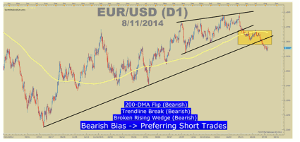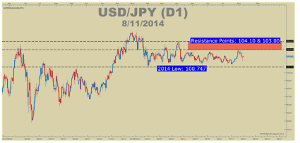Developing a strategy and sticking to it regardless of whether you are in a winning trade or not is the key to continued success as a forex trader, writes Tyler Yell of DailyFX.com.
Trading well is simple but it’s not easy. Due to its simplicity, many traders attempt to jump into a trade figuring it will work out sooner or later. However, a trading plan that involves wishing leaves traders, experienced and new, exposed to a myriad of problems.
Trading Means More Than Wishing You’re Right
Building a Bias
There are many ways to build a bias in trading. A bias is often defined as being bullish, bearish, or indifferent. Many traders like to look at a moving average or a recent price extreme in order to build a bias. Either way, a bias helps you to identify entries with strong risk: reward ratios so that even if your win % isn’t great, you’re still making progress.
Learn Forex: A Bearish Bias Helps You Identify Entries

Presented by FXCM’s Marketscope Charts
Click to Enlarge
Put differently, a bias is finding a direction that you prefer to trade in. This is intended to put the odds in your favor in the spirit of the law of inertia, which states, all things being equal, an object in motion stays in motion until an equivalent or net external force stops the trend.
Another reason why building a bias is helpful is that it can keep you out of low probability trades.
In trading, we can never predict the future but we can see what’s moving and what’s not. If a currency pair isn’t moving, it’s likely best to wait for and confirm a breakout or look for another pair that is making trend progression. If you’re looking to trade trends, it can be costly to tie your margin up in a pair that’s not moving.
Learn Forex: USD/JPY Has Sucked Traders into Its Range

Presented by FXCM’s Marketscope Charts
Click to Enlarge
Finding Out Where or When You’re Wrong
Trading is full of a lot of helpful rules that have stood the test of time but there is one that often stands above the rest. To quote, Jim Rogers, “Your first loss is your best loss.” There is a lot to unpack from this statement but we can save that for another time. What’s important now is to consider that, to manage your trade and your risk, you must decide as soon as possible when the trade is not working out whether in price or time terms.
Some traders are incredibly inpatient, but that can be a good thing. After years of trading, I’ve learned that the best trades often work from the start. Therefore, if my analysis is showing me that a currency pair has the potential to move 75 pips to the upside this week and I enter a trade I have two decisions to make:
- Is the pair trading above my stop (because it’s a Buy order)? (If yes, move to #2.)
- Is this trade acting in a timely manner toward my target? (If not, something may be amiss.)
If I answer yes to both of these questions, then I’m okay. However, if a pair is dragging on in a state of unprofitability, then you’re exposing yourself to unnecessary risk. While we cannot know the future, we can know how much exposure we have on any given trade and that’s where you must develop your skills so as to limit your risk on any one trade.
Taking What the Market Gives You
This is where many traders unfortunately start. They don’t have a bias or method to find out where or when they’re wrong. They simply enter a trade and focus on how much they could make. This type of hope is a dangerous thing.
The preference is to start with a risk point, where you’ll get out of the trade if it doesn’t work out as you want. Only then—in relation to your risk point—should you determine where you’ll get out of the trade if the trade goes into your favor. A further word of advice, pat yourself on the back and move on if your profit target is hit. It’s too easy to watch the trade after you get out, and be upset that you missed the big move.
Emotionally, it’s better to leave the trade once you’ve exited for better or for worse because your risk is limited to when you’re in the trade. If you’re not in the trade, there’s no reason to worry about what could have been. This will allow you to master your approach to the market and not be emotionally subject to its next move when you have no skin in the game.
By Tyler Yell, Trading Instructor, DailyFX.com





















